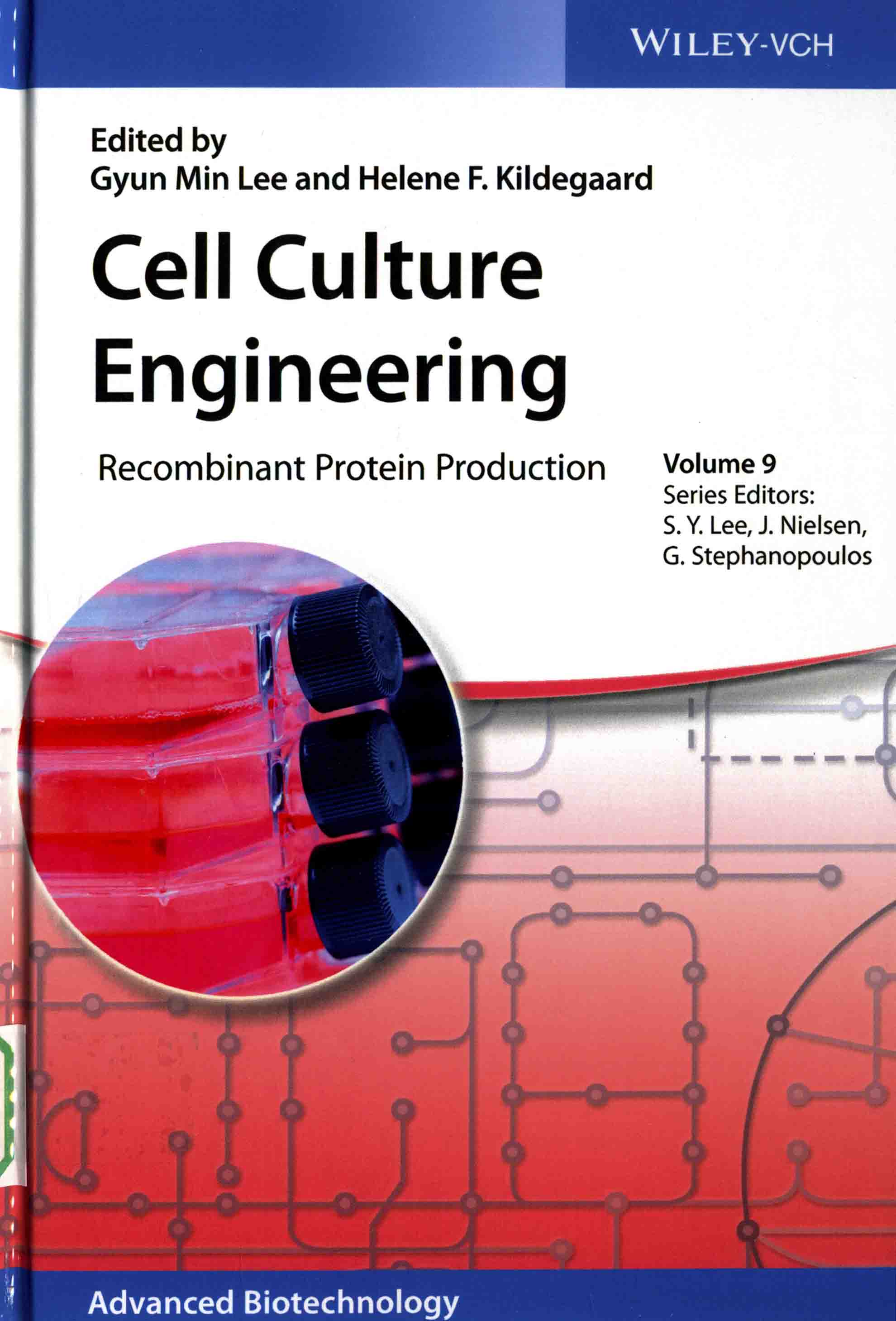 |
Cell culture engineering : recombinant protein production / edited by Gyun Min Lee. -- Weinheim : Wiley-VCH, 2020. – (58.221/C393e) |
Contents
About the Series Editors xvii
1
Platform Technology for Therapeutic Protein Production 1
1.1
Introduction 1
1.2
Overall Trend Analysis 3
1.3
General Guidelines for Recombinant Cell Line Development 6
1.4
Process Development 9
1.5
Downstream Process Development 12
1.6
Trends in Platform Technology Development 14
1.7
Conclusion 17
Acknowledgment 17
Conflict of Interest 17
References 17
2
Cell Line Development for
Therapeutic Protein Production 23
2.1
Introduction 23
2.2
Mammalian Host Cell Lines for Therapeutic Protein Production 25
2.3
Development of Recombinant CHO Cell Lines 27
2.4
Development of Recombinant Human Cell Lines 34
2.5
Important Consideration for Cell Line Development 36
2.6
Conclusion 38
References 38
3
Transient Gene Expression-Based Protein Production in Recombinant
Mammalian Cells 49
3.1
Introduction 49
3.2
Gene Delivery: Transient Transfection Methods 50
3.3
Expression Vectors 53
3.4
Mammalian Cell Lines 54
3.5
Cell Culture Strategies 58
3.6
Large-Scale TGE-Based Protein Production
60
3.7
Concluding Remarks 62
References 62
4
Enhancing Product and Bioprocess
Attributes Using Genome-Scale Models of CHO Metabolism 73
4.1
Introduction 73
4.2
Genome-Scale Metabolic Model 76
4.3
GEM Application 80
4.4
Conclusion 86
Acknowledgments 88
References 88
5
Genome Variation, the Epigenome
and Cellular Phenotypes 97
5.1
Phenotypic Instability in the Context of Mammalian Production Cell
Lines 97
5.2
Genomic Instability 99
5.3
Epigenetics 101
5.4
Control of CHO Cell Phenotype by the Epigenome 105
5.5 Manipulating the Epigenome 107
5.6
Conclusion and Outlook 113
References 114
6 Adaption of Generic Metabolic Models to
Specific Cell Lines for Improved Modeling of Biopharmaceutical Production and
Prediction of Processes 127
6.1
Introduction 127
6.2
Main Source of Optimization Issues with Large Genome-Scale Models:
Thermodynamically Infeasible Cycles 134
6.3
Consideration of Additional Biological Cellular Constraints 144
6.4
Conclusion 152
References 153
7
Toward Integrated Multi-omics
Analysis for Improving CHO Cell Bioprocessing
263
7.1
Introduction 163
7.2
High-Throughput Omics Technologies
165
7.3
Current CHO Multi-omics Applications
172
7.4
Future Prospects 177
References 178
8
CRISPR Toolbox for Mammalian Cell
Engineering 185
8.1
Introduction 185
8.2
Mechanism of CRISPR/Cas9 Genome Editing
186
8.3
Variants of CRISPR-RNA-guided Endonucleases 187
8.4
Experimental Design for CRISPR-mediated Genome Editing 188
8.5
Development of CRISPR/Cas9 Tools
192
8.6
Genome-Scale CRISPR Screening 197
8.7
Applications of CRISPR/Cas9 for CHO Cell Engineering 197
8.8
Conclusion 199
Acknowledgment 200
References 200
9 CHO Cell Engineering for Improved Process
Performance and Product Quality 207
9.1
CHO Cell Engineering 207
9.2
Methods in Cell Line Engineering
208
9.3
Applications of Cell Line Engineering Approaches in CHO Cells 211
9.4
Conclusions 233
References 234
10
Metabolite Profiling of Mammalian Cells
251
10.1
Value of Metabolic Data for the Enhancement of Recombinant Protein
Production 251
10.2
Technologies Used in the Generation of Metabolic Data Sets 252
10.3
Approaches for Metabolic Data Analysis
257
10.4
Implementation of Metabolic Data in Bioprocessing 261
10.5
Future Perspectives 266
Acknowledgments 267
References 267
11
Current Considerations and Future Advances in Chemically Defined Medium
Development for the Production of Protein Therapeutics in CHO Cells 279
11.1
Introduction 279
11.2
Traditional Approach to Medium Development 279
11.3
Future Perspectives for Medium Development 284
Acknowledgment 288
Conflict of Interest 288
References 288
12
Host Cell Proteins During
Biomanufacturing 295
12.1
Introduction 295
12.2
Removal of HCP Impurities 295
12.3
Impacts of Residual HCPs 298
12.4
HCP Detection and Monitoring Methods
300
12.5
Efforts for HCP Control 302
12.6
Future Directions 305
Acknowledgments 306
References 306
13
Mammalian Fed-batch Cell Culture
for Biopharmaceuticals 313
13.1
Introduction 313
13.2
Objectives of Cell Culture Process Development 314
13.3
Cells and Cell Culture Formats
316
13.4
Fed-batch Cultures 317
13.5
Cell Culture Media 319
13.6
Feeding Strategies 321
13.7
Feed Media Design 323
13.8
Process Variable Design 325
13.9
Cell Culture Supplements 327
13.10
New and Emerging Technologies 329
13.11
Future Directions 332
References 333
14
Continuous Biomanufacturing 347
14.1
Introduction 347
14.2
Continuous Upstream (Cell Culture) Processes 347
14.3
Advantages of Continuous Perfusion
351
14.4
Cell Retention Systems for Continuous Perfusion 354
14.5
Operation and Control of Continuous Perfusion Bioreactors 358
14.6
Current Status of Continuous Perfusion
360
14.7
Conclusions 362
Acknowledgment 362
References 363
15
Process Analytical Technology and
Quality by Design for Animal Cell Culture
365
15.1
PAT and QbD - US FDA's Regulatory Initiatives 365
15.2
PAT and QbD - Challenges 365
15.3
PAT and QbD Implementations 366
15.4
Case Studies 370
15.5
Conclusion 383
References 383
16 Development and Qualification of a Cell
Culture Scale-Down Model 391
16.1
Purpose of the Scale-Down Model
391
16.2
Types of Scale-Down Models 392
16.3
Evaluation of a Scale-Down Model
39.5
16.4
Conclusions and Perspectives 401
References 402
Index 407